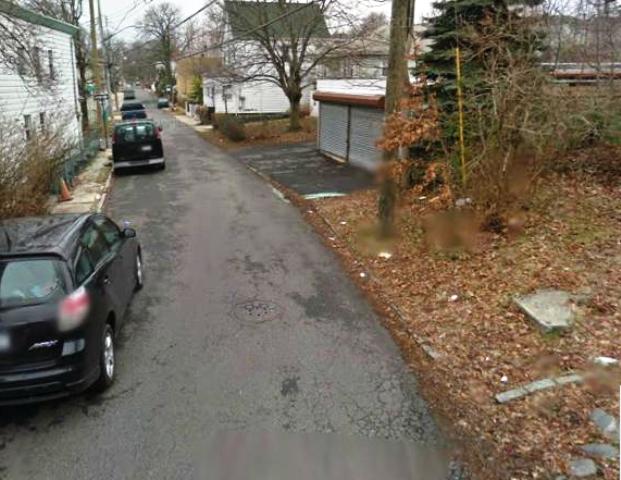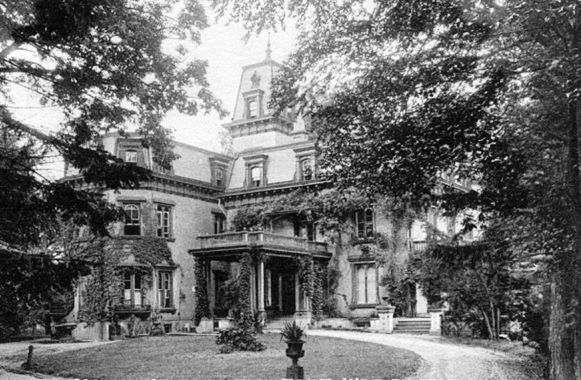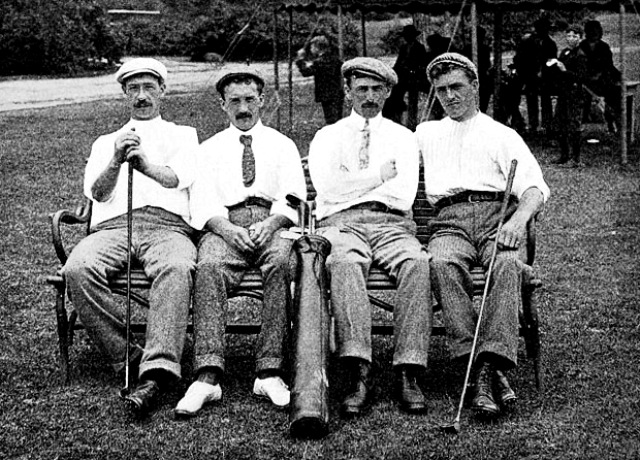Tags: Fox Hills Golf Course, Isaac Mackie, Louis Henry Meyer, Mount Manresa, New York History, Rosebank
4

Staten Island once was home to more than a dozen golf courses. The first was Harbor Hill, which opened in 1878 and was bounded by Brighton, Lafayette, and Prospect Avenue in New Brighton. Another popular course was the semi-private Fox Hills Golf Course in Clifton, which opened in 1900 and was Staten Island’s first 18-hole course.

The
Fox Hills Golf Course members told police that the goats “turn out on
the links like a regiment of soldiers and frighten the women players.”
In some cases, they said, the goats would chase the balls and run away
with them. (In 1902 some cows invaded the course, but that’s another
story for another time.)

The
Fox Hills Golf Course had a clubhouse near Vanderbilt Avenue, which was
then considered the largest golf clubhouse in the country. The
clubhouse stood about where Osgood and Fairway avenues meet today; the
site is now occupied by residential duplexes. New York Public Library Collections
The Health Department in the Borough of Richmond went to war against the goats and their owners. The police also got involved, including Sergeant Shay of the Stapleton Police, who issued summonses to a number of goat owners for violating the sanitary code by keeping goats without a license.

Bell
Street in Rosebank is so narrow it can barely accommodate one car lane.
In the 1800s and early 1900s, this road was a farm trail in a
settlement called “nanny goat hills.” Here, Italian immigrants grew
vegetables, raised goats, and planted fig trees (which is why today you
can still find fig trees in backyards from Rosebank to Tottenville.)
In the 19th century, the area we now call Clifton and Concord was only a small rural hamlet with fishing ponds and wooded trails. Around 1860, Louis Henry Meyer, the former president of the Fort Wayne Railway company and one of the founders of the Staten Island Savings Bank, purchased 18 acres of land along present-day Fingerboard Road.

With the goats gone, golfers including Walter Clark and Isaac Mackie could enjoy a round of golf at Fox Hills in August 1905.
Two years after Meyer’s death in 1898, Fox Hills Golf Club was founded with 200 members. The 18-hole course, which had been laid out on the former Meyer estate by the Staten Island Cricket Club in 1899, boasted the finest links in the tri-state area, with numerous sand traps and a large pond creating challenging obstacles for even the best golfers. (The 13th hole was so difficult it was nicknamed Hell’s Kitchen.) Its grounds encompassed what is today Park Hill (and the Park Hill Apartments), Celebration, and Eibs Pond.

Louis
Meyer named his estate Fox Hills Manor after his passion for fox
hunting. In 1898, following his death, the 20-room estate served as a
boardinghouse. The property then sat empty until Father Shealy purchased
it in 1911 for a Jesuit retreat center, Mount Manresa. The villa was
torn down in the 1960s, and in April 2014, the New York Province of the
Society of Jesus sold the property to a developer of shopping malls and
townhouse neighborhoods. That’s called progress.

Fox Hills pro Isaac Mackie is pictured here (left) at the 1904 U.S. Open with Jack Hobens, Alex Ross, and George Thomson.
The Fox Hills Base Hospital, as it became known, operated until 1922, when it was determined that the rundown hospital had become a firetrap. The facility closed on March 7, 1922, and the few remaining patients were transferred to Sea View Hospital.

The
Fox Hills Base Hospital, as it became known, featured three miles of
interconnected covered wooden walkways with amenities like a barber
shop, billiards room, general store, and 2,000-seat theater. It operated
until 1922, when the last remaining patients were transferred to Sea
View Hospital.
During World War II, the U.S. Army reactivated the old Fox Hills property to serve as an army base, an Italian prisoners of war camp, and a trading post along Vanderbilt Avenue. When the war ended, the barracks became makeshift homes for veterans who faced a severe housing shortage in the late 1940s and early 1950s. The facility shut down completely in the early 1950s.

As
late as the early 1970s, farm animals still grazed at large in Staten
Island. These animals are grazing on yet-to-be-developed land near the
Staten Island Mall on Richmond Avenue in New Springville.